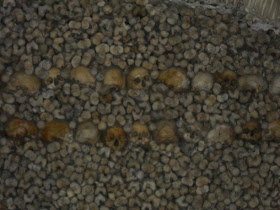This blog is a little out of order, but we will catch up later on Lisbon and Porto. I thought today's explorations were too interesting (or bizarre?) to wait.
Evora is a beautiful little town perfectly preserved from the XIVth century, surrounded by its protective walls reminiscent of Lucca or Sienna.
Wandering through the narrow cobblestoned streets we visited the Templo Romano, the Roman baths, and climbed up to the top of Catedral Evora for an enchanting view of the entire region.
The highlight of our visit, however macabre it may seem, was the chapel built entirely from human bodies.
Due to a lack of valuable land for cemetary space, and a concern that the local residents of the parish were getting too materialistic, the monks decided to relocate the bones of 43 cemetaries and build the “Chapel of Bones”. The Capela dos Ossos was built in the 16th century.
It is a small interior chapel located next to the entrance of the Church of St. Francis. The walls are made solely of human bones, including skulls. The idea was to provoke meditation on life being transitory, and, by association, that material goods and the trappings of wealth are not what the church wishes its followers to aspire to. This is clearly shown in the famous warning at the entrance Nós ossos que aqui estamos pelos vossos esperamos (“We bones that here are, for yours await").
The number of skeletons was calculated to be about 5000, coming from the cemeteries that were situated inside several dozen churches. Some of these skulls have been scribbled with graffiti. Two desiccated corpses, one of which is a child, dangle from ropes. At the roof of chapel, is inscribed the phrase "Melior est die mortis die nativitatis ("Better is the day of death than the day of birth)"
I offered to donate my bones, but my Portugese must be a bit rusty, as they just sold me a postcard instead.
 |
| Lorraine atop Catedral Evora |
 |
| The Cathedral from the Cloister |
 |
| The Templo Romano with the Cathedral in the Distance |
 |
| Temple of Bones |
 |
| Wall from the Temple of Bones |
 |
| We bones that here are, for yours await!! |




















